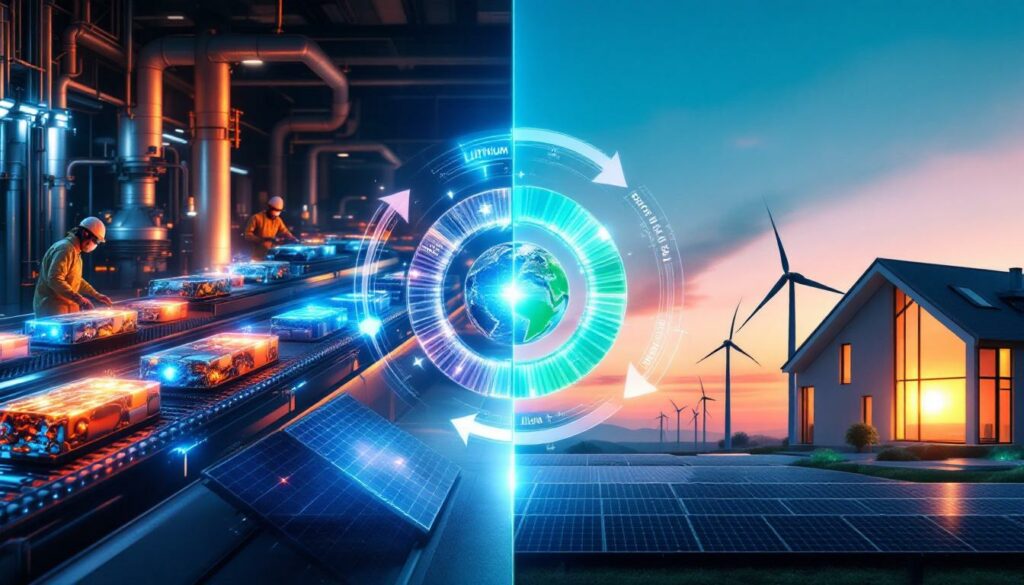Is EV Battery Recycling or a Second Life the Better Option?
As electric vehicle adoption accelerates globally, a critical question emerges: what happens to batteries when they reach the end of their automotive lifecycle? With millions of EV batteries expected to retire in the coming decades, developing sustainable end-of-life strategies has become increasingly important for environmental protection, resource conservation, and economic efficiency.
Why End-of-Life EV Battery Management Matters
The Growing EV Battery Challenge
Electric vehicle adoption is surging worldwide, creating an impending wave of retired batteries. Industry forecasts project that by 2030, over 12 million tonnes of EV batteries will reach their end-of-automotive life, presenting both environmental challenges and economic opportunities.
The proper management of these batteries isn't just an environmental concern—it's becoming a strategic imperative for automakers, energy companies, and governments alike. Without effective end-of-life strategies, valuable resources remain unutilized while potentially hazardous materials risk improper disposal.
The Value Proposition of Used EV Batteries
When an EV battery is deemed unsuitable for automotive use, it typically retains 70-80% of its original capacity—far too valuable to simply discard. These batteries contain precious materials including lithium, cobalt, nickel, and other critical minerals energy transition that represent both environmental concerns and significant economic value.
In 2025, the average EV battery contains approximately $1,000-$2,000 worth of recoverable materials. This value creates a compelling case for developing sophisticated end-of-life strategies rather than allowing these resources to go to waste.
What Are the Two Main End-of-Life Options for EV Batteries?
Battery Recycling Explained
Battery recycling involves dismantling used batteries and processing their components to recover raw materials for manufacturing new batteries. This approach creates a circular economy where critical minerals are continuously reused rather than newly mined.
Modern recycling processes can recover up to 95% of critical materials from lithium-ion batteries through a combination of mechanical separation, hydrometallurgical processes (using aqueous solutions to extract metals), and pyrometallurgical methods (using high-temperature treatments). Recent battery recycling breakthrough technologies continue to advance, improving both efficiency and cost-effectiveness.
Second-Life Applications Defined
Second-life utilization takes a different approach by repurposing automotive batteries for less demanding stationary energy storage applications. Rather than immediately breaking down the battery, this strategy maximizes its useful life before recycling eventually becomes necessary.
These repurposed batteries serve in various applications including:
- Residential solar energy storage systems
- Commercial building backup power supplies
- Grid stabilization and peak shaving solutions
- Renewable energy integration and storage
- Emergency power supplies for critical infrastructure
By extending functional battery life by 5-10 years, second-life applications create additional value before recycling eventually occurs.
How Do Environmental Impacts Compare Between Options?
Carbon Footprint Analysis
Recent comprehensive research conducted by the University of Münster, Fraunhofer Research Facility for Battery Cell Production (FFB), and Lawrence Berkeley National Laboratory reveals significant environmental differences between recycling and second-life applications.
The study found that second-life applications offer superior carbon reduction benefits compared to immediate recycling:
| Strategy | CO₂ Equivalent Savings by 2050 | Equivalent to Removing |
|---|---|---|
| Second Life | 55.8 million tonnes | 12+ million combustion vehicles annually |
| Recycling | 48.3 million tonnes | 10.5 million combustion vehicles annually |
"Reuse comes out on top here… the additional benefit of reuse in a stationary application weighs more heavily in the carbon footprint," noted researchers from the University of Münster's MEET Battery Research Center.
Resource Conservation Benefits
Second-life applications deliver a compounding environmental benefit through multiple mechanisms:
- Delaying the need for new battery production, thereby reducing manufacturing emissions
- Reducing immediate mining impacts and associated ecosystem disruption
- Supporting renewable energy integration, accelerating fossil fuel displacement
- Eventually still allowing for material recovery through recycling after extended use
This sequential approach maximizes both carbon reduction and resource efficiency, creating an optimal environmental pathway for battery materials.
What Are the Economic Considerations for Each Option?
Recycling Economics
Battery recycling offers several compelling economic advantages:
- Creates a domestic supply chain for critical materials in regions dependent on imports
- Reduces geopolitical vulnerabilities related to mining in politically unstable regions
- Stabilizes material costs for battery production as demand outpaces mining capacity
- Generates new skilled jobs in the recycling sector (approximately 15-25 jobs per thousand tonnes of batteries processed)
Research indicates that by 2050, recycling could supply approximately 61% of the materials needed for new EV batteries in regions with mature EV markets like California. This "urban mining" approach transforms what was once considered waste into a valuable domestic resource.
Second-Life Financial Benefits
The second-life strategy presents equally compelling economic arguments:
- Creates additional revenue streams from used batteries (approximately $50-150/kWh of remaining capacity)
- Lowers the total cost of EV ownership when residual battery value is considered
- Provides affordable energy storage solutions for renewable energy at 50-70% of the cost of new batteries
- Develops new business models and market opportunities for energy storage companies
Real-world implementations have demonstrated that second-life battery systems achieve 80-90% round-trip efficiency while delivering up to 3,000 additional cycles beyond their automotive life.
Which Battery Chemistries Are Best Suited for Each Path?
Optimal Chemistries for Recycling
Not all battery chemistries offer equal recycling value, creating different economic incentives:
- High-value recycling candidates: Nickel-cobalt-manganese (NCM) and nickel-cobalt-aluminum (NCA) batteries contain more valuable materials like cobalt (currently $33,000/tonne) and nickel ($16,000/tonne)
- Medium-value recycling candidates: Nickel-manganese-cobalt (NMC) batteries with reduced cobalt content offer moderate material recovery value
- Lower-value recycling candidates: Lithium iron phosphate (LFP) batteries contain fewer expensive materials, making them less economically attractive for recycling
This economic reality creates interesting market dynamics where different battery metals investment strategies may follow different optimal end-of-life pathways.
Ideal Chemistries for Second Life
For second-life applications, different characteristics become important:
- Lithium iron phosphate (LFP): These batteries excel in second-life applications due to their exceptional cycle life (3,000+ cycles) and superior safety profile, making them ideal for stationary storage despite their lower energy density
- Early-generation NMC batteries: These offer a good balance of energy density and longevity, with moderate degradation rates in second-life applications
- Batteries with robust battery management systems: Advanced BMS allows for easier repurposing, better performance monitoring, and more precise state-of-health assessment
The irony is notable: LFP batteries, which contain fewer valuable materials for recycling, often represent the best candidates for second-life applications due to their excellent longevity and stability.
How Are Real-World Second-Life Projects Performing?
Notable Second-Life Implementations
Several successful commercial-scale second-life battery projects demonstrate the viability of this approach:
- Rome Airport Energy Storage: This installation utilizes former Nissan Leaf batteries to manage peak demand and support airport operations, reducing both costs and emissions associated with energy consumption
- Porsche Leipzig Facility: The automotive manufacturer employs used Porsche EV batteries in a 1.5MWh energy storage system at its Leipzig plant, managing energy flows and reducing grid dependency
- Voltfang Commercial Systems: This German startup specializes in converting used EV batteries into commercial energy storage solutions, having deployed multiple systems across industrial applications in Europe
These implementations prove that second-life batteries can reliably perform in demanding commercial environments, not just theoretical applications.
Performance Metrics from Existing Projects
Data from operational second-life systems shows impressive performance:
- 80-90% round-trip efficiency in energy storage applications
- 3,000+ additional cycles in stationary applications
- 5-10 years of extended useful life beyond automotive applications
- 50-70% cost reduction compared to new battery storage systems
These metrics demonstrate that second-life batteries can deliver economically viable performance while creating substantial environmental benefits.
What Does the Future Demand for Battery Materials Look Like?
Projected Material Requirements
The demand for battery materials is expected to increase dramatically as EV adoption accelerates:
| Material | 2025 Demand | 2030 Projected Demand | 2050 Projected Demand |
|---|---|---|---|
| Lithium | 0.5M tonnes | 1.5M tonnes | 4.0M tonnes |
| Cobalt | 0.2M tonnes | 0.4M tonnes | 0.7M tonnes |
| Nickel | 0.3M tonnes | 1.3M tonnes | 2.5M tonnes |
These projections highlight the enormous strain that will be placed on mining operations, making both recycling and extended battery life through second-life applications increasingly critical.
Storage Capacity Needs
Research indicates that by 2030, second-life batteries could potentially meet 100% of stationary storage demand in mature EV markets. This creates a perfect match between retired automotive batteries and the growing need for renewable energy storage.
The ability of second-life batteries to support renewable energy integration represents a critical climate benefit beyond simply avoiding new battery production. By enabling greater renewable energy deployment, these batteries create a multiplier effect in carbon reduction.
How Should We Approach the Recycling vs. Second Life Decision?
The Complementary Approach
Rather than viewing recycling and second-life as competing strategies, experts recommend a sequential approach that maximizes both environmental benefits and economic value:
- Evaluate battery condition at automotive end-of-life through standardized testing
- Direct suitable batteries to second-life applications based on remaining capacity and performance
- Implement recycling when batteries no longer function effectively in second-life roles
- Develop infrastructure for both pathways simultaneously to ensure all batteries follow the optimal path
This integrated approach recognizes that the two strategies are complementary rather than competitive.
Policy and Infrastructure Considerations
Effective implementation requires coordinated action across multiple domains:
- Standardized battery health assessment protocols to determine optimal end-of-life pathways
- Supportive regulatory frameworks for battery repurposing (including simplified certification processes)
- Investment in battery recycling facility development to handle eventual material recovery
- Battery design standards that consider both second-life applications and eventual recycling
- Material passports and digital tracking systems to monitor batteries throughout their lifecycle
The EU Battery Directive represents one of the most comprehensive policy frameworks, establishing collection targets, recycling efficiency standards, and requirements for battery design that facilitates both reuse and recycling.
What Are the Technical Challenges for Each Pathway?
Recycling Technical Hurdles
Battery recycling faces several significant technical challenges:
- Diverse battery designs complicate automated disassembly and sorting
- Safety concerns during dismantling of damaged or degraded batteries
- Energy-intensive processes for material separation, particularly for lithium recovery
- Maintaining material purity during recovery to ensure suitability for new battery production
- Handling increasingly complex battery chemistries as manufacturers continue to innovate
These challenges require continued investment in recycling technology development and process optimization.
Second-Life Implementation Challenges
Repurposing batteries presents different technical issues:
- Battery health assessment and sorting at scale remains difficult and often manual
- Reconfiguration for new voltage and capacity requirements requires specialized expertise
- Integration of diverse battery management systems from different manufacturers
- Long-term performance prediction and warranty considerations in new applications
- Regulatory uncertainty regarding responsibility and liability in second-life applications
Many of these challenges relate to standardization—or rather, the lack thereof—in the EV battery industry, where proprietary designs complicate repurposing efforts.
Which Option Better Supports Supply Chain Security?
Recycling's Role in Supply Independence
Recycling contributes to supply chain security through several mechanisms:
- Reducing dependence on geopolitically sensitive regions like the Democratic Republic of Congo (cobalt) and Chile (lithium)
- Creating domestic sources of critical materials within consuming regions
- Limiting exposure to market price volatility for battery materials
- Mitigating environmental and social impacts of mining, including water use and labor concerns
By 2050, recycling could potentially supply over 60% of critical battery materials in regions with mature EV markets, dramatically reducing import dependencies.
Second Life's Contribution to Resource Efficiency
Second-life applications enhance resource security through complementary means:
- Extending the functional life of already-mined materials by 5-10 years
- Reducing immediate demand for new raw materials during a critical transition period
- Creating buffer time for recycling infrastructure development and technology maturation
- Supporting grid resilience and renewable energy integration, enhancing energy security
The sequential approach—second life followed by recycling—maximizes both immediate and long-term resource security benefits.
What's the Expert Consensus on the Optimal Approach?
Research-Based Recommendations
The scientific consensus based on recent studies suggests a clear pathway:
- Prioritize second-life applications where batteries remain functionally viable
- Develop robust recycling infrastructure in parallel to handle eventual material recovery
- Implement a coordinated system that optimizes material flow based on battery condition
- Consider regional factors that may influence the optimal balance (energy mix, recycling capacity, etc.)
This approach aligns with circular economy principles while maximizing both environmental and economic benefits.
Industry Best Practices
Leading automotive and energy storage companies are adopting integrated approaches that recognize the complementary nature of both strategies:
- Battery design that considers full lifecycle management, including both second life and recycling
- Partnerships between automakers and energy storage providers to streamline battery transitions
- Investment in both recycling technology and second-life applications to create complete solutions
- Development of battery passport systems to track materials throughout multiple lifecycles
These approaches recognize that optimizing battery lifecycle management requires coordination across the entire value chain, supporting broader mining sustainability transformation goals.
What Questions Should Consumers and Policymakers Ask?
Key Considerations for Decision-Makers
When evaluating end-of-life battery strategies, important questions include:
- What is the remaining capacity and health of the battery, and how can it be objectively assessed?
- Are there immediate local needs for energy storage that could be served by second-life batteries?
- What recycling infrastructure is available in the region, and what are its recovery efficiencies?
- Which approach delivers the greatest carbon reduction in the specific context?
- How do economics compare in the specific regional context, considering local energy prices and storage needs?
These questions help guide decision-making toward optimal outcomes in specific contexts.
Future Research Directions
Areas requiring further investigation include:
- Long-term performance of second-life batteries in diverse applications and environments
- Optimizing battery design for multiple lifecycles rather than just initial automotive use
- Improving recycling efficiency and reducing costs, particularly for lithium recovery
- Quantifying total environmental impacts across full battery lifecycles, including mining impacts
Continued research in these areas will further refine our understanding of optimal battery lifecycle management.
Conclusion: The Integrated Lifecycle Approach
The research clearly indicates that the optimal strategy combines both approaches in sequence: first extending battery life through second-life applications where viable, then recycling to recover materials when batteries can no longer serve in stationary storage roles. This integrated approach maximizes both environmental benefits and economic value.
By implementing coordinated planning across production, reuse, and recycling, the industry can create a sustainable circular economy for batteries that conserves resources, reduces greenhouse gas emissions, and supports the clean energy transition.
The environmental advantage of second-life applications (55.8 million tonnes CO₂ equivalent savings by 2050 versus recycling's 48.3 million tonnes) makes a compelling case for prioritizing reuse where technically feasible, while developing recycling capacity in parallel to handle batteries after their second life concludes.
FAQs About EV Battery End-of-Life Options
How long do EV batteries typically last in their original application?
Most EV batteries maintain suitable performance for vehicle use for 8-15 years or 100,000-200,000 miles, depending on battery chemistry, usage patterns, and environmental conditions. Factors like rapid charging frequency, temperature extremes, and depth of discharge can significantly impact longevity.
What percentage of an EV battery can be recycled?
Modern recycling processes can recover up to 95% of the materials in lithium-ion batteries, with recovery rates continuing to improve as technology advances. Cobalt and nickel achieve the highest recovery rates (up to 98%), while lithium recovery remains more challenging (typically 70-80%).
How much longer can a battery function in a second-life application?
Second-life applications typically extend a battery's useful life by an additional 5-10 years beyond its automotive lifespan. This extension varies based on the original battery chemistry, its condition at retirement from automotive use, and the demands of its second-life application.
Which countries are leading in
Ready to Stay Ahead of Major Mineral Discoveries?
Discover significant ASX mineral announcements before the market with Discovery Alert's proprietary Discovery IQ model, delivering real-time insights on potential investment opportunities. Explore how historic discoveries have generated substantial returns by visiting Discovery Alert's dedicated discoveries page and begin your 30-day free trial today.




